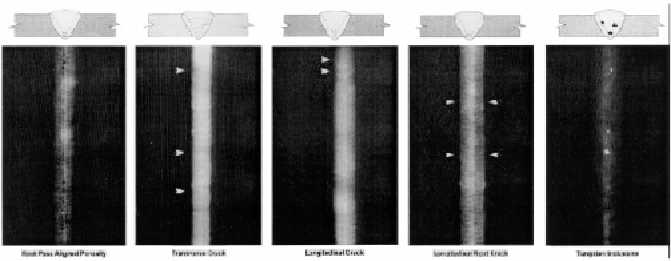T.O. 33B-1-1
Figure 6-45.
Radiographic Examples of Welds (Sheet 2 of 2)
6.8.17.17
Aluminum and Magnesium Welds.
Radiographic technique and equipment for examining welds in aluminum and magnesium alloys are no
different than methods used for steel welds. The discontinuities produced by fusion welding of aluminum and
revealed on film by radiography include:
a.
Entrapped gas, ranging from fine gas porosity to large gas holes. The porosity may be in line or at
random.
b.
Inclusions of tungsten particles, foreign materials, f lux and oxide. Since the density of oxide films is
nearly the same as that of aluminum, they will not produce a detailed indication on a radiograph
unless present in large quantities.
c.
Inadequate penetration.
d.
Incomplete fusion.
e.
Cracks.
f.
Surface irregularities.
6.8.18
Spot Welds.
A special exposure technique is necessary for the inspection of spot welds. The welded areas are X-rayed with
a low-voltage, high-intensity, beryllium-window X-ray tube on extremely fine grained films. Spot welds and
seam welds produce X-ray images of aluminum and its alloys that are entirely different from those of any
other welding technique. Because of the rather large percentage of radiographically dense alloying constitu-
ents that produce informative patterns, some of the high strength aluminum alloys are well suited for spot
weld radiography. The images show positive indications of the following:
a.
Variations in weld nugget shape (oversize, undersize, absence, misshapen, doughnut and crescent
shaped).
b.
Extrusion and expulsion of metal from nugget.
c.
Cracks.
d.
Foreign materials (for example, tip pickup).
e.
Porosity.
f.
Segregation of the alloying elements.
g.
Electrode impressions.
Change 3
6-105

